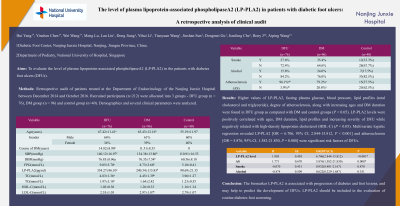Clinical Research
(CR-026) The effect level of plasma lipoprotein-associated phospholipaseA2 (LP-PLA2) in patients with diabetic foot ulcers: A retrospective analysis of clinical audit
Friday, April 28, 2023
7:15 PM - 8:30 PM East Coast USA Time

Johnson Boey, DPM – NUH; YinChen Chen, MD – Endocrinology – Nanjing Junxie Hospital; Wei Wang, MD – Endocrinology – Nanjing Junxie Hospital,; AiPing Wang, MD – Endocrinology – Diabetic Foot Center, Nanjing Junxie Hospital,
Introduction: The quality of life in patients with diabetes has loomed around the effectiveness of preventive and management strategies of diabetic foot complications. Recently there has been evidence of biomarker lipoprotein-associated phospholipase A2 (LP-PLA2) in several inflammatory conditions. Therefore, we conducted a study to evaluate the LP-PLA2 in patients with foot ulcerations and their diagnostic role in predicting diabetic foot ulcers.
Methods: Retrospective audit of patients treated at the Department of Endocrinology of the Nanjing Junxie Hospital between December 2014 and October 2016. Recruited participants (n=212) were allocated into 3 groups, DFU group (n = 76), DM group (n = 96) and control group (n=40). Demographics and several clinical parameters were analyzed.
Results: Higher values of LP-PLA2, fasting plasma glucose, blood pressure, lipid profiles (total cholesterol and triglyceride), degree of atherosclerosis, along with increasing ages and DM duration were found in DFU group as compared with DM and control groups (P < 0.05). LP-PLA2 levels were positively correlated with ages, DM duration, lipid profiles and increasing severity of DFU while negatively related with high-density lipoprotein cholesterol (HDL-C) (P < 0.05). Multivariate logistic regression revealed LP-PLA2 [OR = 6.706, 95% CI, 2.844-15.812, P < 0.001] and atherosclerosis [OR = 5.876, 95% CI, 1.582-21.830, P = 0.008] were significant risk factors of DFUs.
Discussion: The biomarker LP-PLA2 is associated with progression of diabetes and foot lesions, and may help to predict the development of DFUs. LP-PLA2 should be included in the evaluation of routine diabetes foot screening.
Methods: Retrospective audit of patients treated at the Department of Endocrinology of the Nanjing Junxie Hospital between December 2014 and October 2016. Recruited participants (n=212) were allocated into 3 groups, DFU group (n = 76), DM group (n = 96) and control group (n=40). Demographics and several clinical parameters were analyzed.
Results: Higher values of LP-PLA2, fasting plasma glucose, blood pressure, lipid profiles (total cholesterol and triglyceride), degree of atherosclerosis, along with increasing ages and DM duration were found in DFU group as compared with DM and control groups (P < 0.05). LP-PLA2 levels were positively correlated with ages, DM duration, lipid profiles and increasing severity of DFU while negatively related with high-density lipoprotein cholesterol (HDL-C) (P < 0.05). Multivariate logistic regression revealed LP-PLA2 [OR = 6.706, 95% CI, 2.844-15.812, P < 0.001] and atherosclerosis [OR = 5.876, 95% CI, 1.582-21.830, P = 0.008] were significant risk factors of DFUs.
Discussion: The biomarker LP-PLA2 is associated with progression of diabetes and foot lesions, and may help to predict the development of DFUs. LP-PLA2 should be included in the evaluation of routine diabetes foot screening.

.png)